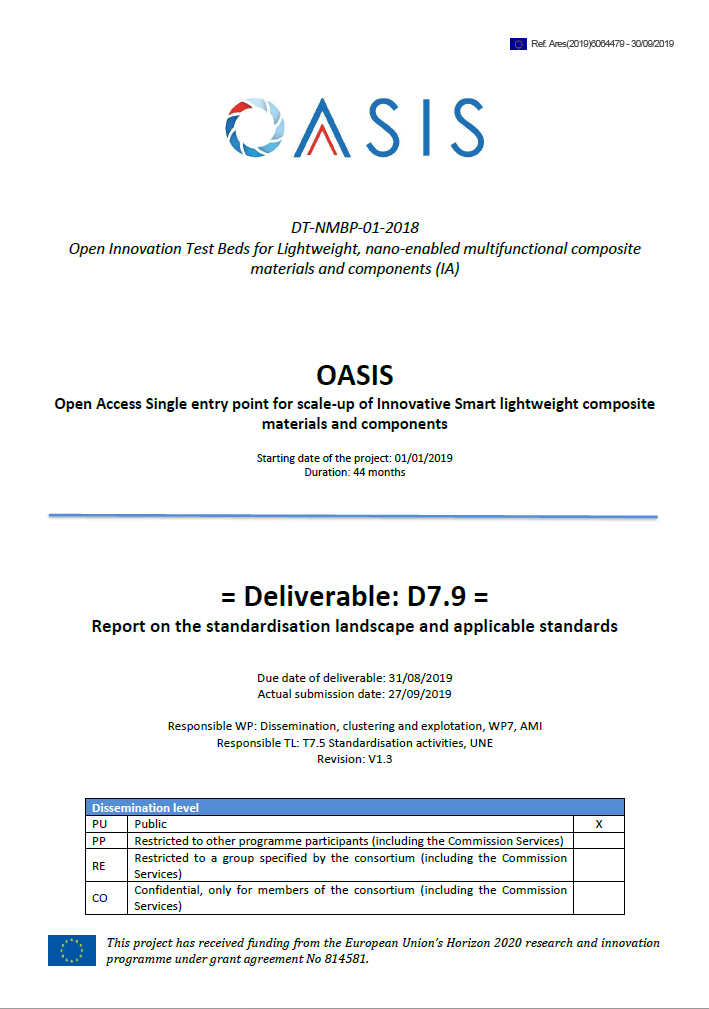
Standardisation Landscape and applicable standards for nano-enabled multifunctional lightweight composites and products made thereof (OASIS project deliverable)
This document is a report on the standardisation landscape and applicable standards relevant to the OASIS project. The OASIS project aims at fulfilling market potential of nano-enabled multifunctional lightweight products by:
- Gathering the manufacturing capacity of 12 pilot lines from nanoparticles to final product.
- Establishing a thorough service offer for associated technical & business development
- Granting direct access to the whole ecosystem through a Single Entry Point, for easier access especially for SMEs.
Oriented towards enhanced polymermatrix composites and aluminium, the pilot lines cover the whole manufacturing chain from nanoscale structures in unprocessed form, to intermediate products with nanoscale features and finally nano-enabled products. So, as to provide full support to interested companies, the new “Open Innovation Test Bed” will also offer complementary technical (modelling, characterization, toxicology, life cycle assessment) and non-technical services (business innovation coaching, business planning, access to private capital). These modular services will be provided to companies, particularly to SMEs, to gain access to unique facilities and knowledge without high capital investment. Such support is particularly needed at the crossroads between three KETs (nanotechnologies, advanced materials and advanced manufacturing and processes) and in an era of multifunctional products when wide scope of know-how is needed for pre-production or industrial low-medium volume production.
The aim of this report is to provide an initial analysis of the standardisation landscape relevant for the project. This document has been produced with the objective of being a useful document to the stakeholders involved in OASIS, and as a first step towards the development of the following tasks:
- Development of a guide document that will ease the Test Bed users to identify the relevant standardisation environment and the relevant knowledge and contacts to start the process to standardise their innovative products.
- Contribution to the ongoing and future standardisation developments.
The OASIS project identified at its Kick-off meeting the development of a Guideline for a Sustainable Manufacturing Framework as an appropriate potential future standardisation development under the leadership of OASIS. Therefore, this search for the relevant standardisation landscape is mainly oriented to contribute to tasks T1.1 of OASIS, i.e. definition of the OASIS Sustainable Manufacturing Framework (SMF), and is focused on key relevant and applicable standards for the field of nanotechnology, avoiding the production of massive lists of documents not fully aimed to nano-manufacturing.
This document starts with a short introduction to standardisation, helping to understand what it is and how it works. It identifies the key players at International and European level and provides information on the different kinds of standardisation deliverables, as well as practical information regarding its coding. Useful information on the abbreviations and acronyms commonly used in standardisation is also given.
The core of the document is divided into two main areas:
- Identification of the relevant standardisation technical bodies developing standards relevant to nanotechnologies (subclause 2.3) and of its main documents (subclause 2.5).
- Identification of the relevant standardisation technical bodies developing standards relevant to a sustainable manufacturing framework (subclause 2.4) and of its main documents (subclause 2.6).
A key trigger for the European standardisation on nanotechnologies was the European Commission Mandate (current standardisation requests) M/461 for standardisation activities regarding nanotechnologies and nanomaterials. This is the reason why the standards currently developed and being developed under M/461 are referenced in this report, as well as the European technical bodies involved.
The document identifies 4 key European and International technical bodies directly focusing on the development of standards relevant to nanotechnologies. Those are:
- CEN/TC 352, Nanotechnologies, and
- ISO/TC 229, Nanotechnologies, both covering the non-electrotechnical aspects of nanotechnologies
- CLC/SR 113, Nanotechnology standardization for electrical and electronics products and systems, and
- IEC/TC 113, Nanotechnology for electrotechnical products and systems, covering the electrotechnical aspects of nanotechnologies
The documents of CEN/TC 352 and ISO/TC 229 are the most significant ones on its field, and are structured in this document under the following criteria:
- General documents, including terminology and nomenclature, material specifications and products and applications
- Measurement, characterization and performance evaluation, with a separate list of those documents on Carbon Nano Tubes (CNT)
- Sustainability, consumer and societal dimensions
- Health, safety and environmental aspects, with a separate list of those documents on nano-objects and their aggregates and agglomerates (NOOA)
Other European technical bodies have been identified focused on nanotechnologies. However, only CEN/WS MODA, Materials modelling, terminology, classification and metadata had developed a new standardisation deliverable on this field when this document was drafted: CWA 17284, on computational material modelling and simulation. CEN/TC 137, Assessment of workplace exposure to chemical and biological agents, and CEN/TC 195, Air filters for general air cleaning, are the two European standardisation technical bodies apart from CEN/TC 352 developing standards under M/461. However, most of their work is not focused on nanotechnologies. Due to this, its documents have been classified in 2 categories: those that are directly related to M/461 and to nanotechnologies and those that are not.
Other European standardisation technical bodies are not focused on nanotechnologies, but develop documents related to them. Documents from CEN/248/WG 26, Textiles -Test methods for analysis of EC restricted substances, CEN/TC 264, Air quality, CEN/TC 298, Pigments and extenders, CEN/TC 430, Nuclear energy, nuclear technologies, and radiological protection, CEN/TC 459/SC 1, Test methods for steel (other than chemical analysis), CLC/SR 47F, Micro-electromechanical systems and, CLC/SR 68, Magnetic alloys and steels, have been identified under this category.
This document focuses in the formal International and European standardisation system. However, reference is made to the works of the technical Committee E56 on Nanotechnology of ASTM International and of the American Concrete Institute, ACI.
On sustainability, besides the works of CEN/TC 352, ISO/TC 229, CEN/TC 137 and CEN/TC 195, there is a high number of technical bodies developing standards that can help to shape an OASIS sustainable manufacturing framework. They have been classified according to the following criteria:
- General standardisation works relevant to sustainability. Some works of ISO/TMBG (ISO Guide 82), CEN/WS 072, Framework for SustainValue - Sustainable Value Creation in manufacturing networks, ISO/TC 127, Earth-moving machinery, CEN/TC 350, Sustainability of construction works, ISO/TC 59/SC 17, Sustainability in buildings and civil engineering works, Technical Committee E60.13 on Sustainable Manufacturing of ASTM International and of the OECD (OECD Sustainable Manufacturing Toolkit) have been identified relevant to this category.
- Standardisation works focused on the social aspect of sustainability, with a special focus on occupational health and safety. Some works of ISO/TMBG (ISO 26000 on Social Responsibility, ISO 20400 on Sustainable procurement), ISO/TC 283, Occupational health and safety management, ISO/TC 262, Risk management, CEN/TC 114 and ISO/TC 199 , Safety of machinery, CEN/TC 122, Ergonomics , and of ISO/TC 159/SC 3, Anthropometry and biomechanics, have been identified relevant to this category.
- Standardisation works focused on the environmental aspect of sustainability. Some works of ISO/TC 207, Environmental management, have been identified relevant to this category.
- Standardisation works focused on the economic aspect of sustainability. Some works of ISO/TC 176/SC 2 , Quality systems, and of the Spanish standards body, UNE, have been identified relevant to this category.

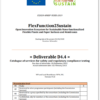

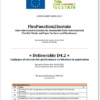
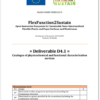
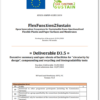
Standardisation Landscape and applicable standards for nano-enabled multifunctional lightweight composites and products made thereof (OASIS project deliverable) 0 reviews
Login to Write Your ReviewThere are no reviews yet.